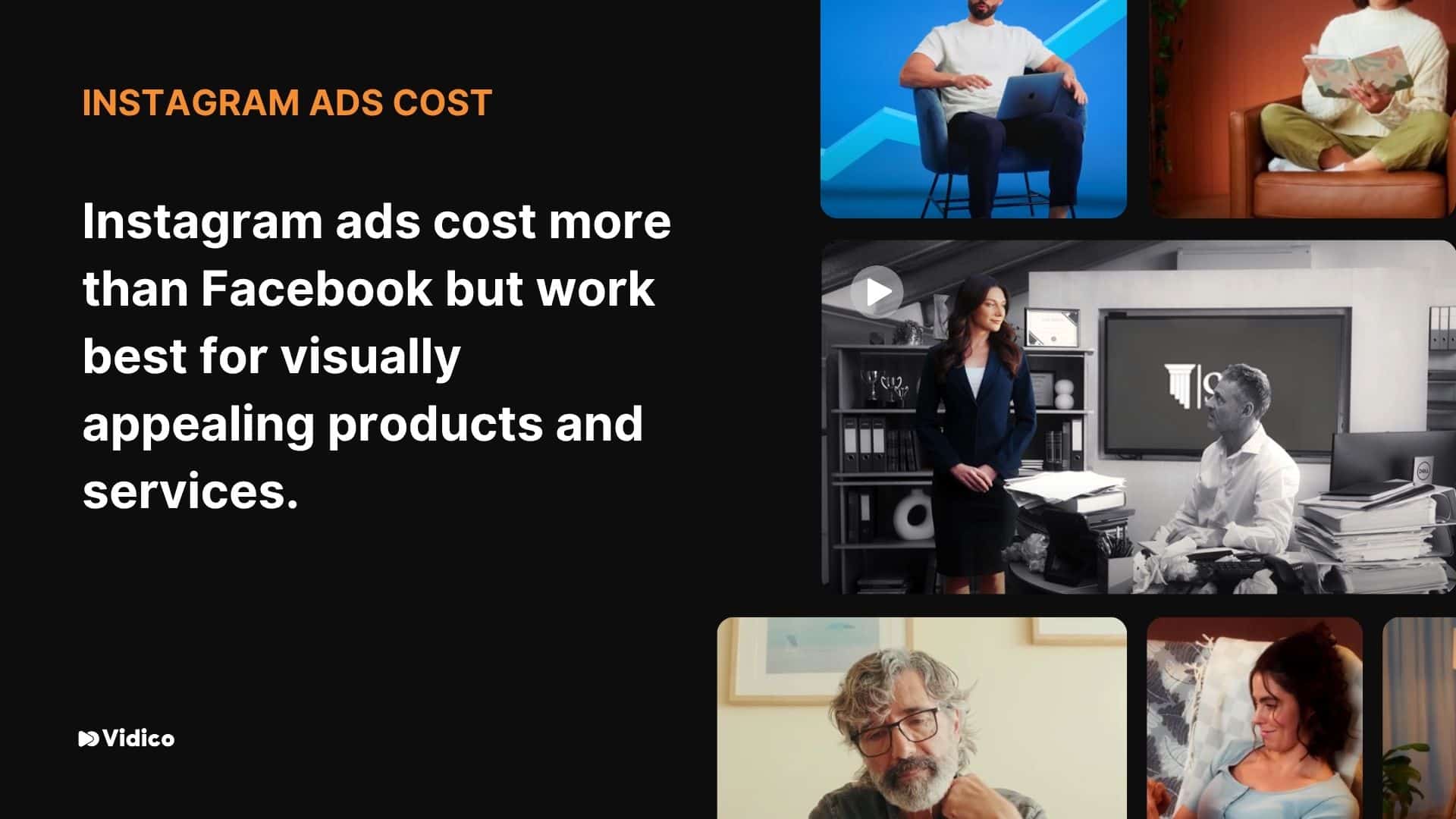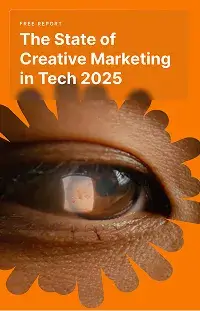If you’re running a business today, online advertising is likely a key part of your marketing strategy. But figuring out how much online advertising costs can feel overwhelming. There are so many options—from Google Ads to social media advertising—and prices seem to change constantly.
In this guide, we’ll break down online advertising costs for all major platforms in simple terms. You’ll learn what affects ad prices, how to plan your advertising budget, and how to get the most value from your ad spend. Whether you’re new to digital advertising or looking to improve your current approach, this article will help you understand the real costs of promoting your business online.
Key Takeaways:
- Google Search ads average $1-$5 per click, while display ads cost $0.50-$1
- Social media costs vary widely: Facebook ($0.50-$2), Instagram ($0.70-$2.80), LinkedIn ($5-$15)
- Industry competition dramatically impacts costs (legal and insurance are highest)
- Ad quality and relevance directly influence costs across all platforms
- Small businesses typically spend $300-$5,000 monthly on digital advertising
What Factors Affect Online Advertising Costs?
Before we dive into specific platforms, it’s important to understand what makes online advertising costs go up or down. These factors apply across most online advertising platforms:
1. Your Target Audience
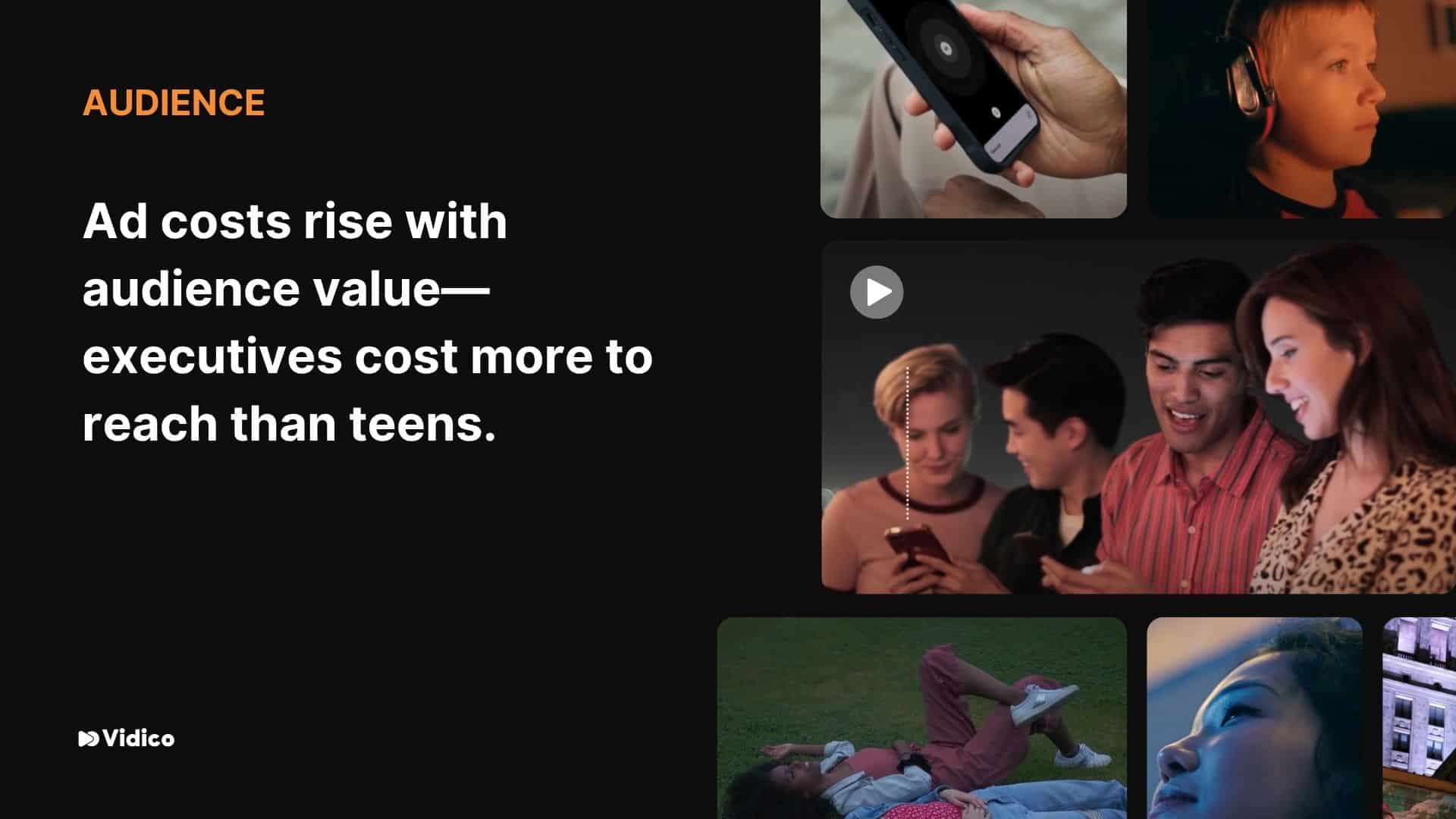
Who you’re trying to reach has a huge impact on your advertising costs. Some audiences are more expensive to target than others. For example, reaching business executives through LinkedIn ads will generally cost more than reaching teenagers on TikTok. The more specific and valuable your target audience, the higher your costs might be.
2. Competition in Your Industry
If lots of businesses are trying to reach the same audience, online advertising costs go up. Industries like insurance, loans, and legal services typically have very high ad costs because competition is fierce. Local businesses in less competitive markets often enjoy lower costs.
Watch What You Need from a Creative Agency in 2025 to see what today’s fastest-growing brands are prioritizing.
3. Ad Quality and Relevance
Most online advertising platforms, especially Google Ads, reward relevant, high-quality ads with lower costs. Creating ads that truly connect with your target audience and match what they’re looking for can actually save you money over time.
4. Time of Year
Advertising costs can change with the seasons. During holiday shopping periods (like Black Friday or Christmas), ad costs often spike as more businesses compete for attention. Planning your ad spend around these fluctuations can help you get better value.
5. Ad Format and Placement
The type of ad you choose matters. Video ads often cost more than simple text ads. Ads that appear at the top of Google search results typically cost more than display network ads that appear on random websites. Your choice of ad format affects both visibility and price.
Online Advertising Costs by Platform
Now let’s look at what you can expect to pay on each major online advertising platform. Remember that these are average ranges—your actual costs might vary based on the factors we just discussed.
Google Ads Costs
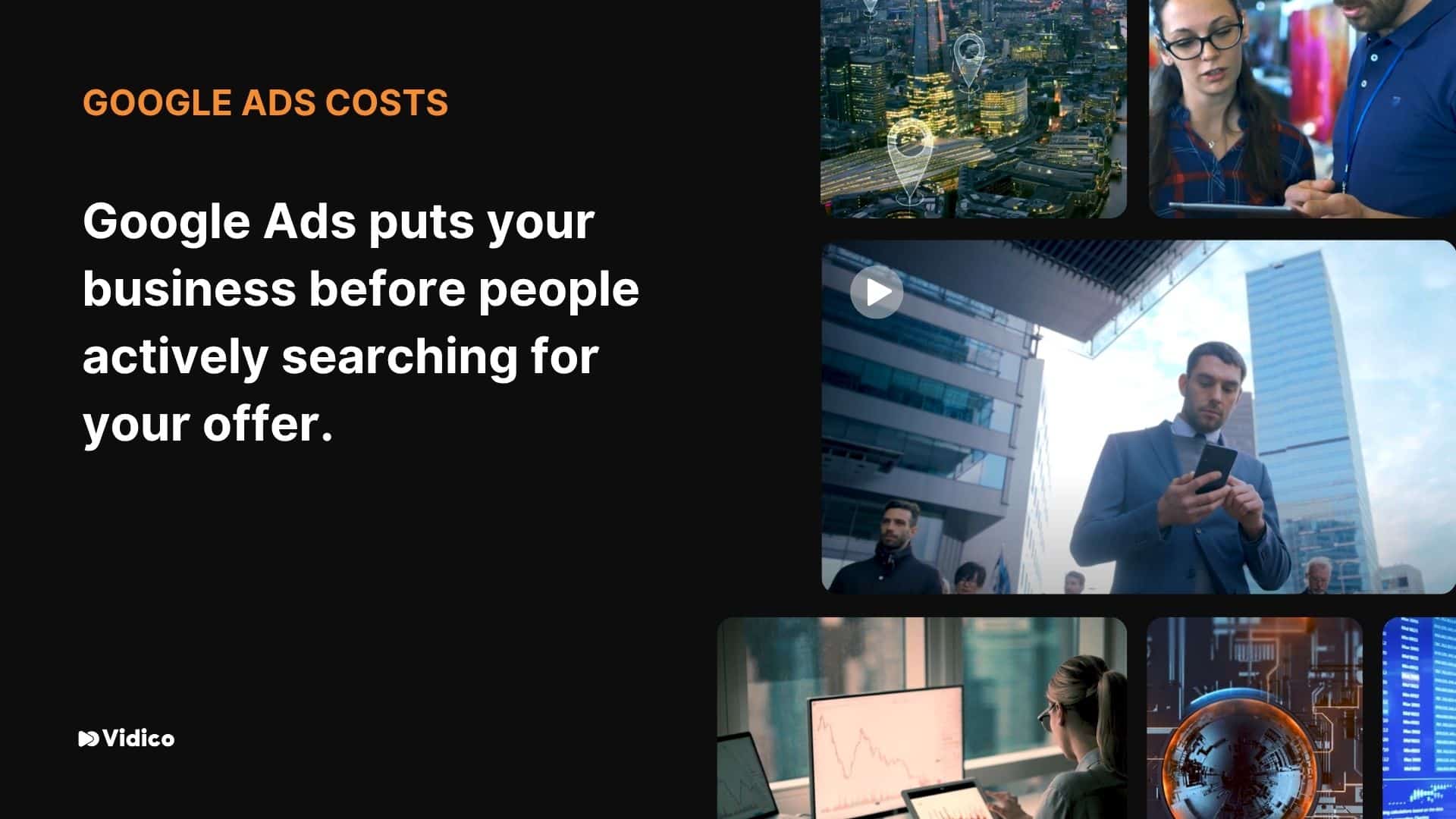
Google Ads (formerly Google AdWords) remains one of the most popular online advertising platforms, and for good reason—it puts your business in front of people actively searching for what you offer.
Search Network Costs:
- Average cost per click (CPC): $1-$5 for most industries
- Higher competition industries: $5-$50+ per click
- Typical daily ad budget: $10-$100 for small businesses
- Monthly ad spend: $300-$3,000 for most small to medium businesses
The Google Search Network is so powerful because it targets people already looking for your products or services. When someone searches “plumber near me” or “best running shoes,” your ad can appear right when they need it.
Google Display Network Costs:
- Average CPC: $0.50-$1
- Typical cost per 1,000 impressions (CPM): $1-$3
- Monthly ad spend: $300-$1,000 for decent exposure
The Google Display Network shows banner ads across millions of websites, reaching potential customers while they’re browsing other content. While clicks cost less than on the Search Network, conversion rates are typically lower too.
YouTube Ads Costs:
- Average cost per view: $0.10-$0.30
- Monthly ad spend: $500-$2,000 for small to medium campaigns
Video ads on YouTube can help build brand awareness and show your product or service in action. With YouTube ads, you often pay only when someone chooses to watch your ad (or watches at least 30 seconds of it).
Subscribe to the Video for Growth Newsletter for weekly tips and insights.
Facebook Ads Cost
Facebook remains one of the most cost-effective online advertising platforms, especially for building brand awareness and reaching specific communities.
- Average CPC: $0.50-$2.00
- Cost per 1,000 impressions (CPM): $5-$10
- Monthly ad spend: $200-$1,500 for small businesses
What makes Facebook ads powerful is the detailed targeting options. You can target people based on interests, behaviors, demographics, and even life events. This precision helps you reach just the right audience for your business.
The platform uses an ad auction system to determine which ads get shown and how much they cost. Creating relevant, engaging ads can help you win more auctions at lower prices.
Instagram Ads Cost 
Instagram ads are run through the same system as Facebook ads, but there are some differences in performance and cost.
- Average CPC: $0.70-$2.80
- Cost per 1,000 impressions (CPM): $6-$12
- Instagram ads cost slightly more than Facebook ads on average
Instagram ads work well for products and services with strong visual appeal. If your business looks good in pictures or short videos, Instagram ads might be worth the slightly higher cost compared to Facebook ads.
LinkedIn Ads Cost
LinkedIn is the premier platform for B2B marketing and professional targeting, but it comes at a higher price point.
- Average CPC: $5-$15
- Cost per 1,000 impressions (CPM): $30-$50
- Monthly ad spend: $1,000-$5,000+ for effective campaigns
LinkedIn ads cost more than other social media advertising, but they can be worth it if you’re selling to businesses or professionals. The ability to target by job title, company size, industry, and skills makes LinkedIn uniquely valuable for B2B marketing.
Twitter Ads Cost
Twitter offers lower costs than LinkedIn but higher engagement rates than the display network.
- Average CPC: $0.50-$2.00
- Cost per 1,000 impressions (CPM): $5-$10
- Monthly ad spend: $300-$1,000 for small businesses
Twitter ads work well for timely messages and connecting with current conversations. If your brand has a strong voice or wants to join trending topics, Twitter ads might be a good fit.
Bing Ads Cost
Microsoft’s Bing Ads (now called Microsoft Advertising) often offers better value than Google Ads because there’s less competition.
- Average CPC: 20-50% lower than Google Ads in the same industry
- Monthly ad spend: $200-$1,000 for small businesses
While Bing has a smaller audience than Google, it still captures around 30% of desktop searches in the US. Many advertisers find that the lower competition and costs make Bing ads a worthwhile addition to their online advertising strategy.
What’s the cost of a scroll-stopping video ad? Get a quoteBreak through the noise with high-performing video ads. Get a fast, transparent estimate tailored to your online advertising goals.
How Different Ad Types Affect Your Costs
The type of ad you choose plays a huge role in your online advertising costs. Here’s a breakdown of common ad formats and how they typically price out:
Text Ads
Simple text ads on search engines are typically priced on a cost-per-click (CPC) basis. These are the standard ads you see at the top of search results on Google or Bing.
- Pro: Generally lower cost entry point
- Con: Limited visual impact
Banner Ads
Banner ads are visual ads that appear on websites that are part of ad networks like the Google Display Network.
- Pro: Lower CPC than search ads
- Con: Often lower conversion rates
- Typical cost: $0.50-$1.00 per click
Video Ads
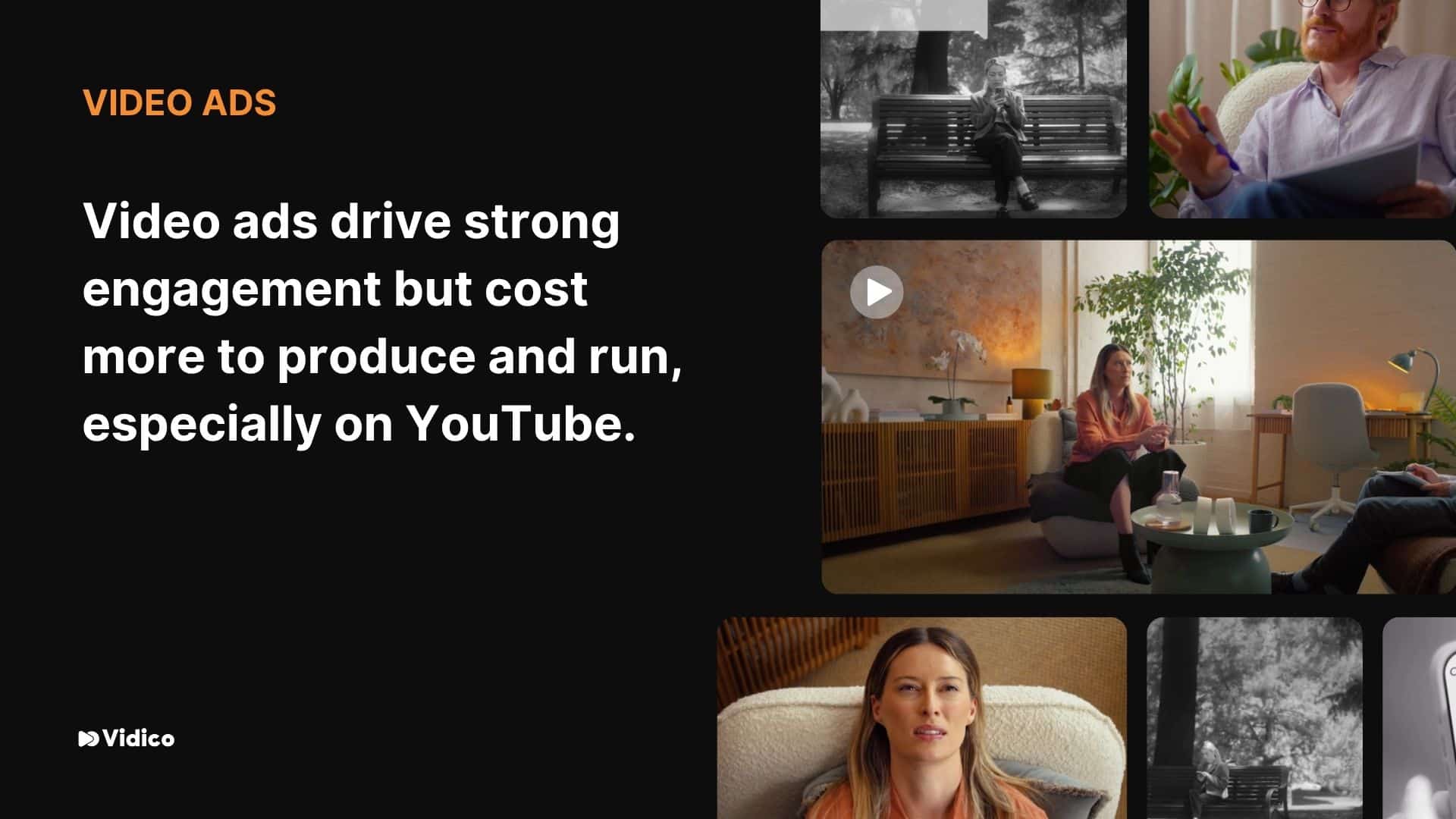
Video ads on platforms like YouTube, Facebook, and Instagram tend to be more expensive to produce and run, but they can create stronger connections with viewers.
- Pro: Higher engagement and emotional impact
- Con: Higher production and placement costs
- YouTube ads cost range: $0.10-$0.30 per view or $10-$30 per 1,000 views
Download a free video script to kickstart your next creative project.
Social Media Ads
The cost of social media advertising varies widely depending on the platform, format, and targeting options you choose.
- Facebook ads cost: $0.50-$2.00 per click
- Instagram ads cost: $0.70-$2.80 per click
- LinkedIn ads cost: $5-$15 per click
Each social media platform offers unique ad formats optimized for their users’ behaviors. From Instagram Stories to Facebook Carousel ads, choosing the right format for your message is key to getting good results.
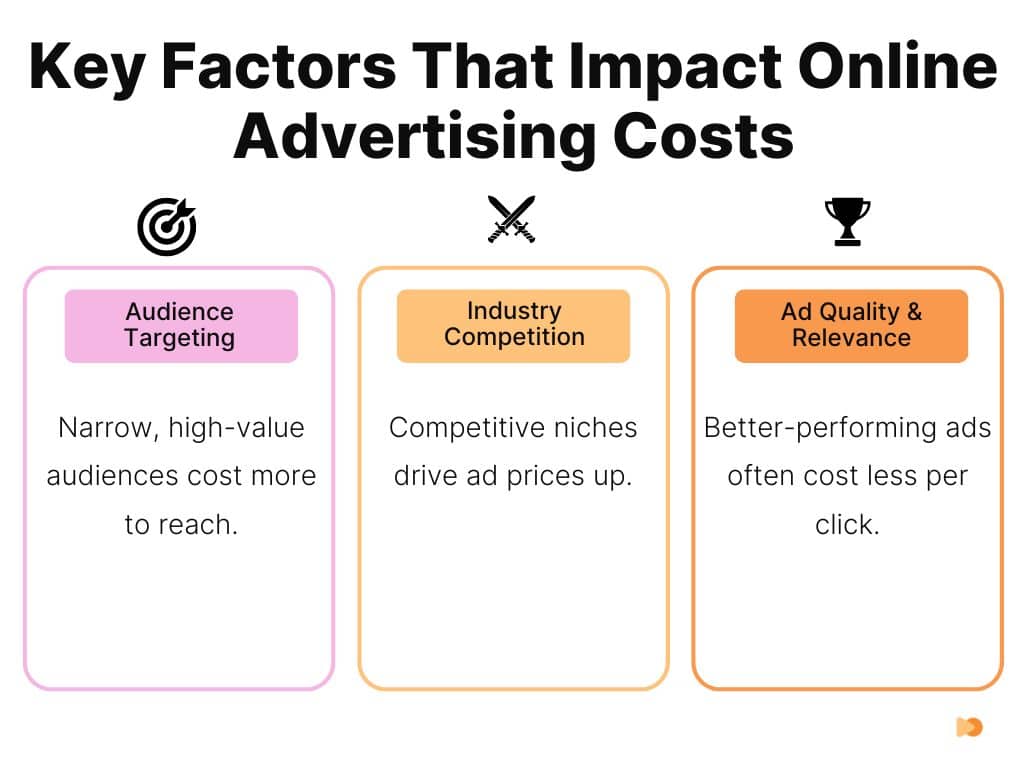
PPC Advertising Costs Explained
Pay-per-click (PPC) advertising is one of the most common pricing models for online ads. Here’s what you need to know:
How PPC Ads Work
With PPC advertising, you only pay when someone clicks on your ad. This model is popular because it means you’re only paying for actual interest, not just impressions.
The actual price you pay per click is determined through an ad auction. Every time someone searches (or in the case of display ads, loads a webpage), an instant auction happens to determine which ads appear and how much the advertiser pays if their ad gets clicked.
Factors That Affect Your Cost Per Click
Several things can make your cost per click higher or lower:
- Quality Score: Google and other platforms assign your ads a quality score based on relevance, landing page experience, and expected click-through rate. Higher quality scores can dramatically lower your costs.
- Bid Amount: How much you’re willing to pay per click affects both whether your ad shows and how much you actually pay.
- Ad Rank: Your position in search results affects your cost and visibility. Higher positions generally cost more but get more clicks.
- Industry Competition: Some keywords simply cost more because lots of companies want to appear for those terms.
Average CPC by Industry
The average cost per click varies dramatically by industry:
- Legal services: $6-$15
- Insurance: $5-$12
- Financial services: $4-$10
- Home services: $2.50-$6
- Retail: $1-$3
- Travel: $1-$3
- Food & Beverage: $0.70-$2
Controlling Your PPC Advertising Costs
To keep your PPC costs manageable:
- Set Clear Daily Ad Budget Limits: Most platforms allow you to set a daily maximum spend.
- Focus on Quality: Improving your ad relevance and landing pages can lower your cost per click.
- Target More Specific Keywords: Sometimes more specific phrases cost less than broad, general terms.
- Use Negative Keywords: Prevent your ads from showing for searches that aren’t relevant to your business.
- Schedule Your Ads: Run ads only during the times when your target audience is most likely to convert.
Social Media Advertising Cost Breakdown
Social media advertising has become essential for most businesses. Here’s a closer look at costs across different social platforms:
Facebook Ads Cost Factors
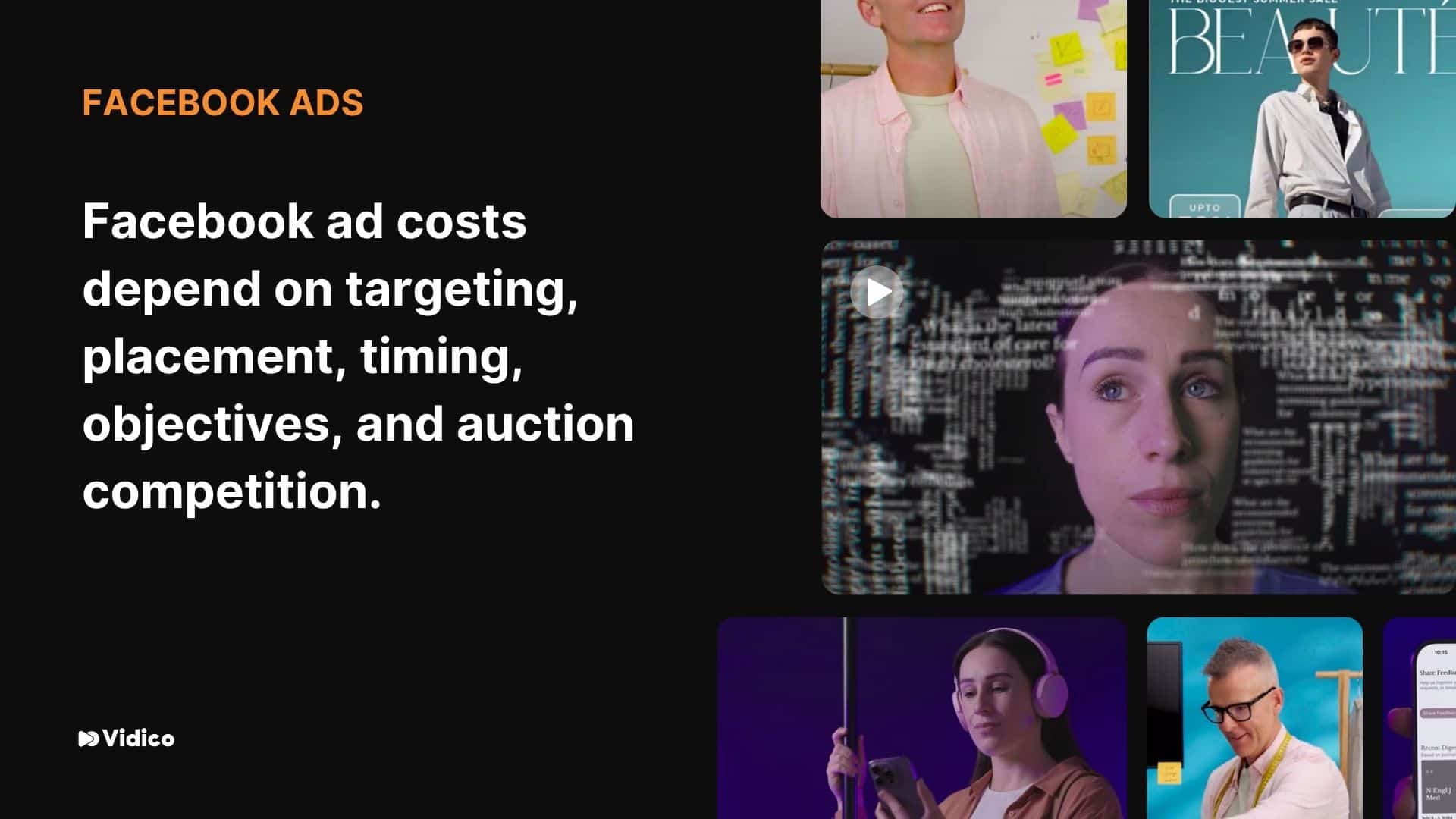
Facebook ads cost varies based on:
- Audience targeting specificity
- Ad placement (News Feed, Stories, Right Column, etc.)
- Time of year (costs rise during holiday seasons)
- Ad objective (awareness vs. conversion)
Facebook uses an auction system where you compete with other advertisers for the same audience. Creating relevant, engaging ads can help you win more auctions at lower costs.
Use our Creative Brief Template to streamline your next campaign.
Instagram Ads Cost Considerations
Instagram is owned by Meta (formerly Facebook) and uses the same ad system, but there are some differences:
- Instagram users are generally younger
- Visual content is more important
- Instagram ads cost slightly more than Facebook
- Stories ads typically cost less than Feed ads
LinkedIn Ads: Worth the Higher Price?
LinkedIn ads cost significantly more than other social media platforms but can be worth it for B2B companies:
- Target by job title, company size, industry, skills
- Typically 5-10x higher CPC than Facebook
- Better for high-value B2B products and services
- Format options include sponsored content, message ads, and text ads
Twitter, Pinterest, and Other Social Platforms
Each social media platform has its own cost structure:
- Twitter: Similar to Facebook in cost, good for timely messages
- Pinterest: Great for visual products, home decor, fashion, recipes
- TikTok: Growing platform with competitive rates, popular with younger audiences
- Snapchat: Lower cost option to reach teen and young adult audiences
Choosing the Right Social Media Advertising Mix
Most businesses find the best results come from using multiple social media platforms, with each playing a specific role in their marketing strategy:
- Facebook: Broad reach and detailed targeting
- Instagram: Visual products and younger audiences
- LinkedIn: B2B and professional services
- Others: Based on where your specific audience spends time
Display Advertising Costs
Display advertising refers to the visual banner ads that appear on websites across the internet. These ads are typically run through networks like the Google Display Network.
Google Display Network Costs
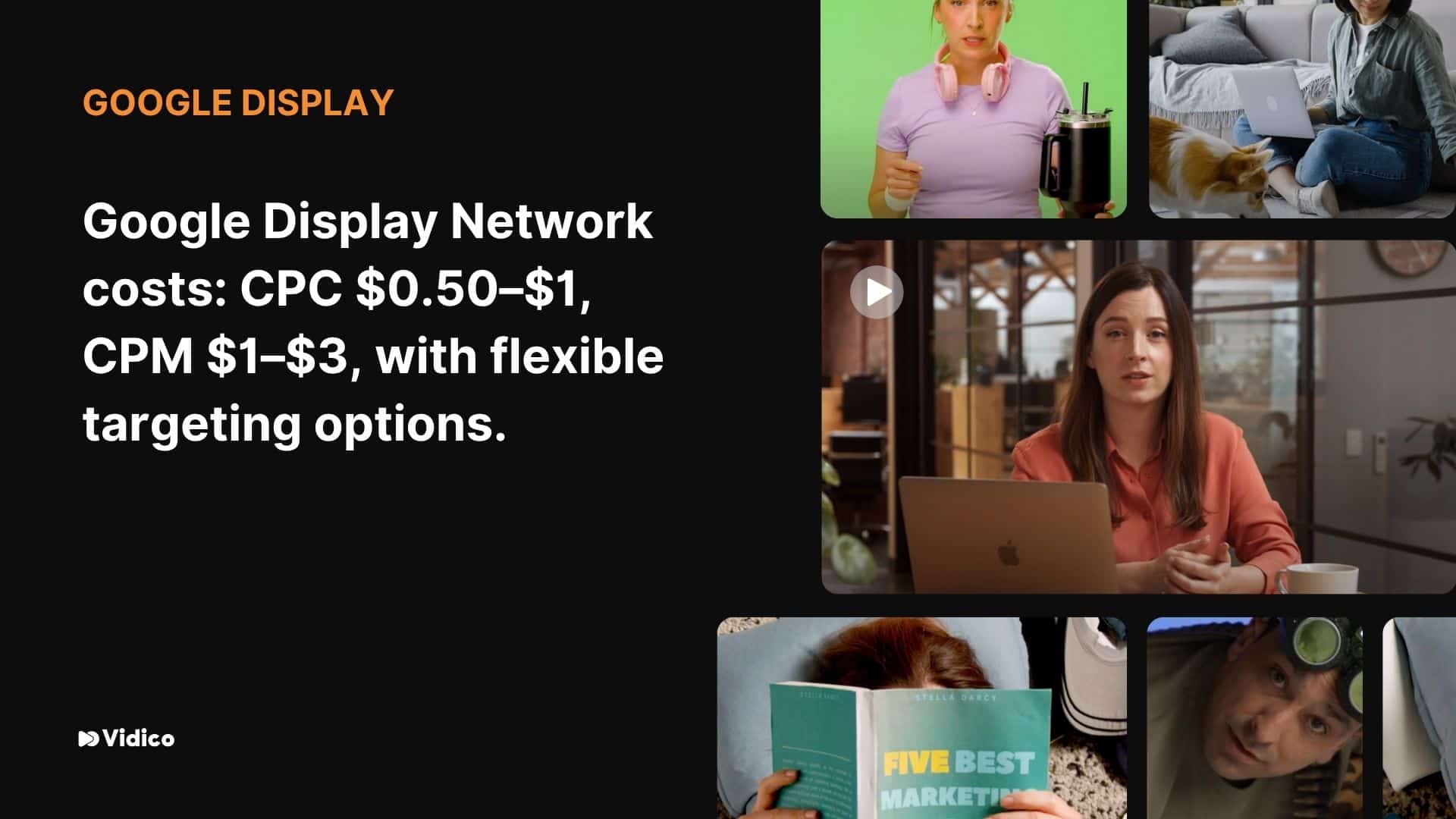
The Google Display Network includes millions of websites where your banner ads can appear:
- Average CPC: $0.50-$1.00
- Average CPM (cost per thousand impressions): $1-$3
- Targeting options: interests, demographics, specific websites, retargeting
Retargeting Ad Costs
Retargeting (showing ads to people who’ve previously visited your website) is often the most cost-effective form of display advertising:
- Average CPC: 30-50% lower than standard display ads
- Higher conversion rates than regular display ads
- Smaller potential audience (limited to previous visitors)
Programmatic Display Advertising
Programmatic advertising uses automated systems to buy and place ads:
- Typically more efficient than manual placements
- Average CPM: $1-$4
- Allows real-time optimization
Native Advertising Costs
Native ads match the look and feel of the content around them:
- Average CPC: $0.75-$1.50
- Higher engagement rates than standard display ads
- Often feels less intrusive to users
Get your free video marketing plan tailored to your funnel and business goals.
Setting Your Online Advertising Budget
One of the most common questions businesses ask is: “How much should I spend on online advertising?” Here’s how to approach this question:
For Small Businesses
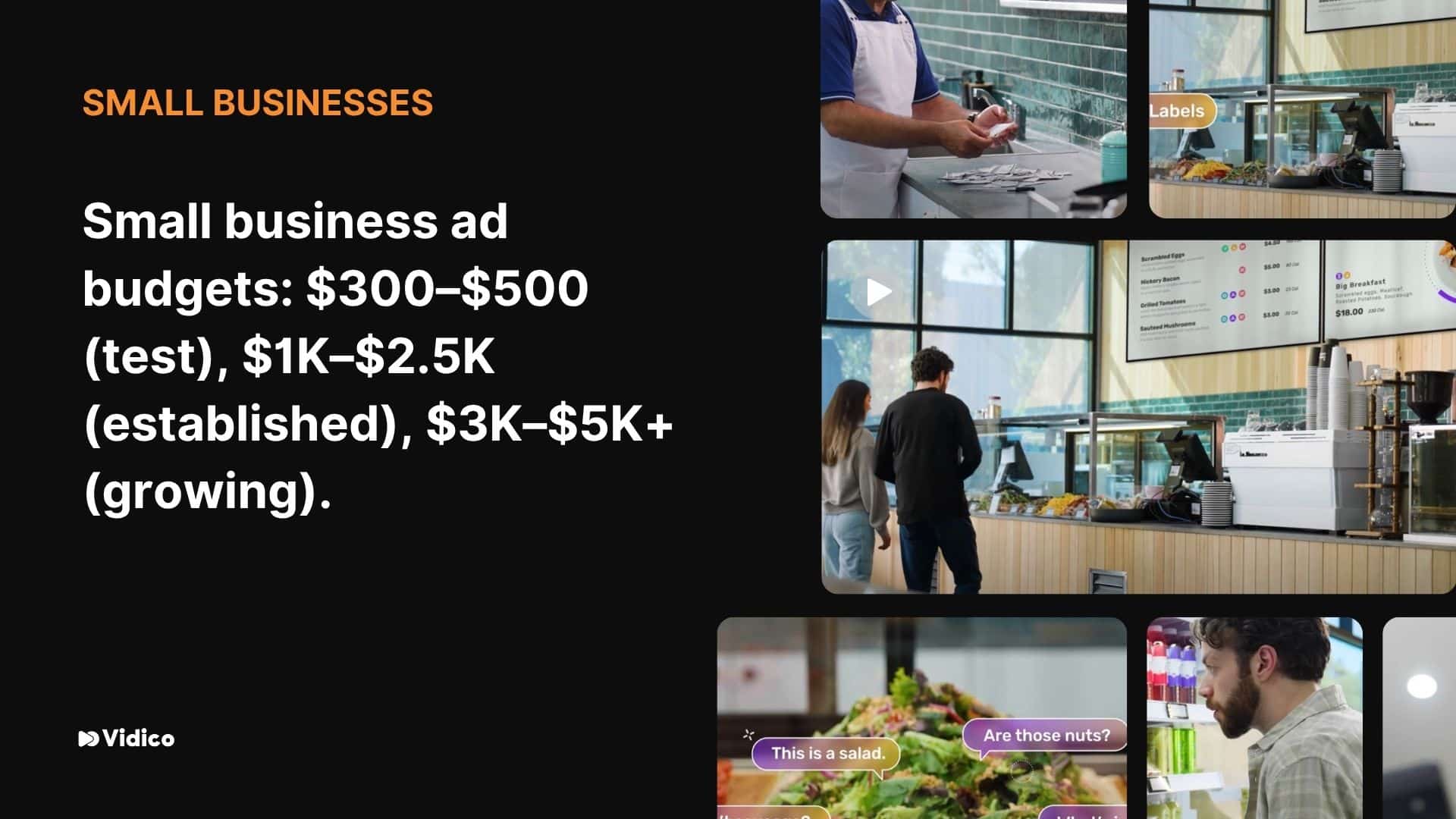
Small businesses and small business owners typically start with these ranges:
- Minimal test budget: $300-$500 per month
- Established small business: $1,000-$2,500 per month
- Growing small business: $3,000-$5,000+ per month
Percentage of Revenue Approach
Many businesses allocate a percentage of revenue to their marketing budget:
- New businesses: 12-20% of revenue
- Established businesses: 6-12% of revenue
- Of this marketing budget, online advertising might represent 30-50%
By Objective
Your advertising budget should align with your goals:
- Brand awareness campaigns: Higher initial investment with longer-term payoff
- Direct response/sales: Can start smaller and scale based on ROI
- New product launch: Often requires higher initial spend
Budget Allocation Across Platforms
How you divide your online advertising budget depends on your business type and goals:
- E-commerce: 60% search ads, 20% social, 20% display/other
- Local service business: 70% search ads, 20% social, 10% display/other
- B2B: 40% search, 40% LinkedIn, 20% display/retargeting
Measuring ROI on Your Online Ad Campaigns
The true cost of online advertising must be measured against the results it delivers. Here’s how to evaluate whether your ad spend is worth it:
Key Metrics to Track
- Cost per acquisition (CPA): How much you spend to get one customer
- Return on ad spend (ROAS): For every dollar spent, how much revenue you generate
- Conversion rate: What percentage of ad clicks turn into customers
- Customer lifetime value (CLV): How much a customer is worth over time
Setting Up Proper Tracking
To measure these metrics, you’ll need:
- Conversion tracking on your website
- Attribution modeling to understand which ads lead to sales
- Analytics to track user behavior after clicking ads
Tools for Tracking Ad Performance
- Google Analytics (free)
- Platform-specific tools (Google Ads, Facebook Ads Manager)
- Third-party analytics software for more advanced tracking
How to Reduce Your Online Advertising Costs
No matter your budget, getting more value from your ad spend is always a priority. Here are strategies to reduce your online advertising costs:
Improve Ad Quality and Relevance
- Write more compelling ad copy
- Create more targeted ad groups
- Improve your landing pages
- Test different ad creative regularly
Refine Your Targeting
- Focus on your most valuable customer segments
- Use retargeting to reach people already familiar with your brand
- Exclude audiences unlikely to convert
Optimize Bidding Strategies
- Use automated bidding when it makes sense
- Set different bids for different times and devices
- Consider using lifetime budget instead of daily budgets for some campaigns
Test and Iterate
- A/B test ad creative
- Try different landing pages
- Experiment with various targeting options
- Start small, then scale what works
Talk to an expert and explore the right approach for your next campaign.
Online Advertising vs. Traditional Advertising Costs
How does internet advertising compare to traditional methods? Here’s a quick comparison:
Cost Comparison
- TV commercial: $5,000-$20,000+ for production, $10-$30 per 1,000 viewers
- Radio ad: $200-$1,000 for production, $5-$25 per 1,000 listeners
- Print ad (magazine): $2,000-$5,000 per full-page ad
- Billboard: $1,500-$4,000 per month
- Online advertising: Can start at just $5-$10 per day
Advantages of Online Advertising
- Lower entry costs
- Precise targeting
- Measurable results
- Ability to start small and scale
- Quick to launch and adjust
When Traditional Advertising Makes Sense
- Building broad local awareness
- Reaching audiences that aren’t online
- Some luxury or premium brands where context matters
- Complementing your digital strategy
Many businesses find the best results come from combining online advertising with strategic traditional marketing channels.
Choosing the Right Online Advertising Platforms for Your Business
With so many online advertising platforms available, how do you choose where to invest your budget? Here’s a framework to help:
By Business Type
For E-commerce:
- Google Shopping ads
- Facebook and Instagram ads
- Pinterest (for visual products)
- Retargeting campaigns
For Local Services:
- Google Search ads with local targeting
- Google Local Service ads
- Facebook ads with geographic targeting
- Bing ads (often less competition)
For B2B Companies:
- LinkedIn ads
- Google Search targeting business keywords
- Retargeting
- Content syndication networks
By Marketing Goal
For Brand Awareness:
- YouTube ads
- Social media advertising
- Display network campaigns
- Native advertising
For Driving Sales:
- Google Search ads
- Shopping ads
- Facebook/Instagram conversion campaigns
For Lead Generation:
- LinkedIn ads for B2B
- Google Search ads
- Facebook lead generation campaigns
Common Online Advertising Mistakes to Avoid
Many businesses waste money on online advertising by making these common mistakes:
Not Tracking Results Properly
Without proper tracking, you can’t know if your ad spend is generating returns. Set up conversion tracking from day one.
Targeting Too Broadly
Showing ads to everyone wastes money. Focus on the specific audiences most likely to become customers.
Ignoring Mobile Users
More than half of web traffic is mobile. Make sure your ads and landing pages work well on phones.
Poor Landing Pages
Even the best ad will fail if it sends traffic to a confusing or slow landing page. Your landing page should deliver on the promise of your ad.
Set-and-Forget Campaigns
Online advertising requires ongoing optimization. Regularly review performance and make improvements.
Not Testing Different Approaches
What works for one business might not work for yours. Test different platforms, ad formats, and messages.
Toggl increased conversion rates by 32% and reduced cost-per-acquisition by 27% using our video system for their product launch campaign → See our work
Online Advertising Costs for Tech and SaaS Companies
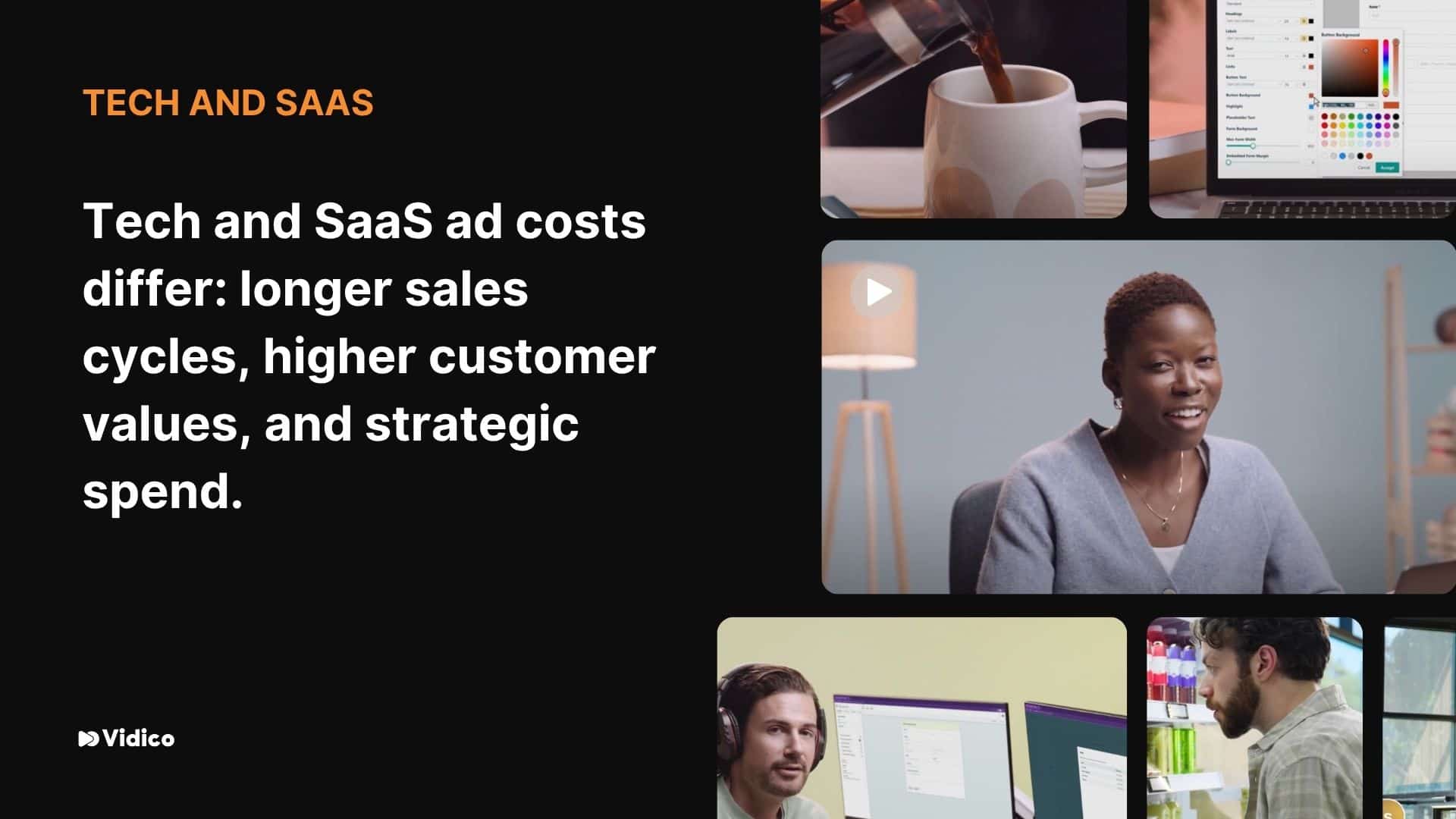
If you’re running a tech or SaaS company, your online advertising costs and strategy will look different from other industries. Tech products often have longer sales cycles but higher customer values, changing how much you can spend to get a new customer.
What Tech Companies Typically Pay for Online Ads
Google Ads:
- Average cost per click: $3-$7 (about 40% higher than the average across all industries)
- Competitive keywords like “cloud software” or “business analytics” can cost $10-$20 per click
- Monthly ad spend: $3,000-$20,000 for most growth-stage tech companies
LinkedIn Ads:
- Average cost per click: $6-$12
- Especially good for B2B tech companies targeting specific job titles
- Higher cost but often better quality leads for enterprise software
Facebook/Instagram Ads:
- Average cost per click: $1-$3 for tech audience targeting
- Works well for apps, consumer tech, and retargeting campaigns
- Good for building brand awareness before using search ads
YouTube Ads:
- Great for demonstrating complex products
- Average cost per view: $0.10-$0.30
- Particularly effective for software with visual features
Why Tech Marketing Has Different Ad Costs
There are a few reasons why advertising costs look different for tech companies:
- Higher customer value: Since software customers often subscribe for years, you can afford to spend more to acquire each customer
- More complex products: Tech products sometimes need more explanation, requiring multiple ad touches before someone converts
- Specific audience targeting: Reaching IT decision-makers or developers costs more than targeting general consumers
- Competitive bidding: Well-funded tech companies often bid up the prices for the same keywords and audiences
Best Ad Channels for Different Tech Companies
The right mix of online advertising platforms depends on what you’re selling:
For B2B Software:
- Google Search ads for people actively looking for solutions
- LinkedIn ads for targeting by job title and company size
- Retargeting to nurture leads through longer sales cycles
For Consumer Tech:
- Instagram and Facebook for product discovery
- YouTube for demonstrations
- Google Search for capturing high-intent traffic
For Enterprise Software:
- LinkedIn for reaching decision-makers
- Content marketing supported by paid distribution
- Search campaigns for specific pain points
Getting the Most from Your Tech Ad Budget
Tech and SaaS companies can improve their advertising results by:
- Understanding your unit economics: Calculate your customer lifetime value to know how much you can afford to spend on acquisition
- Creating educational content: Instead of just promoting your product, use ads to share valuable content that helps potential customers understand their problems better
- Using video effectively: Show your product in action through video ads rather than just telling people about features
- Focusing on the right metrics: Look beyond cost per click to cost per qualified lead and customer acquisition cost
- Testing different ad formats: Try various creative approaches and ad formats to see what resonates with your specific audience
The most successful tech companies view advertising costs as an investment rather than an expense. By tracking the right metrics and continuously improving your campaigns, online advertising can become a predictable engine for growing your tech or SaaS business.
The Future of Online Advertising Costs
What can we expect for online advertising costs in the coming years?
Trends to Watch
- Increasing competition will likely drive costs higher in many sectors
- Better targeting may improve ROI despite higher costs
- Privacy changes (like cookie restrictions) may impact targeting capabilities
- AI and automation will play a bigger role in optimization
- Video and interactive formats will continue to grow in importance
Preparing for Future Changes
- Build first-party data (email lists, customer information)
- Diversify across multiple advertising platforms
- Stay educated about new ad formats and technologies
- Focus on creating better ads, not just spending more
Also read: How Much Does a Marketing Video Cost
Frequently Asked Questions
How much do online ads cost for a small business?
Small businesses typically spend between $300-$5,000 per month on online advertising. A minimal test budget starts around $300-$500 monthly, while established small businesses often spend $1,000-$2,500 monthly. Growing small businesses might invest $3,000-$5,000+ monthly. The exact amount depends on your industry, goals, and which advertising platforms you choose.
Which online advertising platform is the cheapest?
Generally, the Google Display Network and Facebook ads offer the lowest cost entry points, with clicks often available for under $1. However, “cheapest” isn’t always best—what matters is the return on your ad spend. Sometimes paying more for clicks on Google Search ads or LinkedIn ads delivers better results because the traffic is more targeted.
How much do Google Ads cost?
Google Ads costs vary widely by industry and keyword competition:
- Search Network: $1-$5 per click for most industries, but competitive fields like legal or insurance can range from $5-$50+ per click
- Display Network: $0.50-$1 per click
- YouTube ads: $0.10-$0.30 per view Most small businesses spend $300-$3,000 monthly on Google advertising.
What affects the cost of Facebook ads?
Facebook ads cost is influenced by several factors:
- Your target audience (more specific audiences can cost more)
- The ad auction competition for that audience
- Your ad relevance score
- Seasonal trends (holiday seasons are more expensive)
- Ad placement (News Feed, Stories, etc.) The average cost per click for Facebook ads ranges from $0.50-$2.00.
Do Facebook ads or Google Ads cost more?
On average, Google Search ads cost more per click than Facebook ads. Google Search ads average $1-$5 per click for most industries, while Facebook ads average $0.50-$2.00 per click. However, Google ads often convert better because they target people actively searching for your products or services, while Facebook ads reach people based on interests and demographics.
How much do Instagram ads cost?
Instagram ads cost slightly more than Facebook ads, with an average cost per click of $0.70-$2.80. The cost per 1,000 impressions (CPM) typically ranges from $6-$12. Instagram is owned by Meta and uses the same ad system as Facebook, but the different user behavior and higher visual emphasis contribute to the price difference.
What’s a good budget for starting with online advertising?
A good starting budget is $500-$1,000 per month, split across 2-3 channels. This gives you enough data to learn what works without risking too much. Start with a platform where your audience is most active—Google Ads for search intent, Facebook/Instagram for consumer products, or LinkedIn for B2B services.
How long before I see results from online advertising?
For direct response campaigns (focused on sales or leads), you should see initial results within 1-4 weeks. Brand awareness campaigns may take 2-3 months to show meaningful impact. The key is to set up proper tracking from the beginning so you can measure results accurately and optimize your campaigns based on data.
Are online advertising costs going up or down?
Overall, online advertising costs have been trending upward as more businesses shift budgets to digital platforms. However, this varies by platform and industry. Emerging platforms often offer lower costs initially to attract advertisers, while established platforms with high competition (like Google Ads for insurance or legal terms) continue to see price increases.
How do I know if my online advertising is worth the cost?
Calculate your return on ad spend (ROAS) by dividing the revenue generated by your ad cost. For example, if you spend $1,000 on ads and generate $3,000 in sales, your ROAS is 3:1. Most businesses aim for at least 3:1 ROAS for direct response ads. For lead generation, track your cost per lead and compare it to your average customer value.
Should I use an agency or run my own online ad campaigns?
For budgets under $1,000 monthly, self-management often makes more sense as agency fees would eat up too much of your budget. For $1,000-$5,000 monthly, consider using simplified management tools or freelancers. For budgets over $5,000 monthly, agencies can provide expertise and time savings that justify their fees (typically 15-20% of ad spend or a flat monthly rate).
How often should I change my online ads?
Review performance weekly but avoid making too many changes at once. For search ads, you might refresh ad copy every 3-6 months. For display and social ads, creative can burn out faster—plan to refresh visuals every 4-8 weeks. Always test new ads against your current best performers rather than replacing everything at once.
What’s the minimum I can spend on online advertising?
Technically, platforms like Facebook and Google Ads let you start with as little as $5-$10 daily. However, to gather enough data for meaningful optimization, plan to spend at least $300-$500 monthly on your initial test campaigns. Anything less will make it difficult to draw reliable conclusions about what’s working.
Are there any hidden costs in online advertising?
Beyond the direct ad spend, consider these potential additional costs:
- Creative development (graphics, video production)
- Landing page development
- Tracking and analytics tools
- Agency or consultant fees if you don’t manage campaigns yourself
- Time spent on management and optimization
Include these in your total budget calculations when planning your online advertising investment.
Getting Started with Online Advertising
Online advertising costs vary widely based on your industry, target audience, and chosen platforms. Here’s how to get started regardless of your budget:
- Start small and test: Begin with a modest budget spread across 2-3 platforms
- Track everything: Set up proper analytics before spending a dollar
- Focus on one goal: Whether it’s sales, leads, or awareness, pick one primary objective
- Optimize relentlessly: Use data to improve your campaigns over time
- Scale what works: Once you find profitable campaigns, gradually increase spending
Remember that online advertising costs should be viewed as an investment, not an expense. When done right, online ad campaigns generate measurable returns that help your business grow.
By understanding the factors that influence online advertising costs and applying the strategies in this guide, you’ll be well-positioned to make the most of your advertising budget—whether you’re spending $500 or $50,000 per month.
Ready to dive in? Start by defining your goals, setting a test budget, and choosing the platform that best aligns with your business objectives. The world of online advertising awaits!

